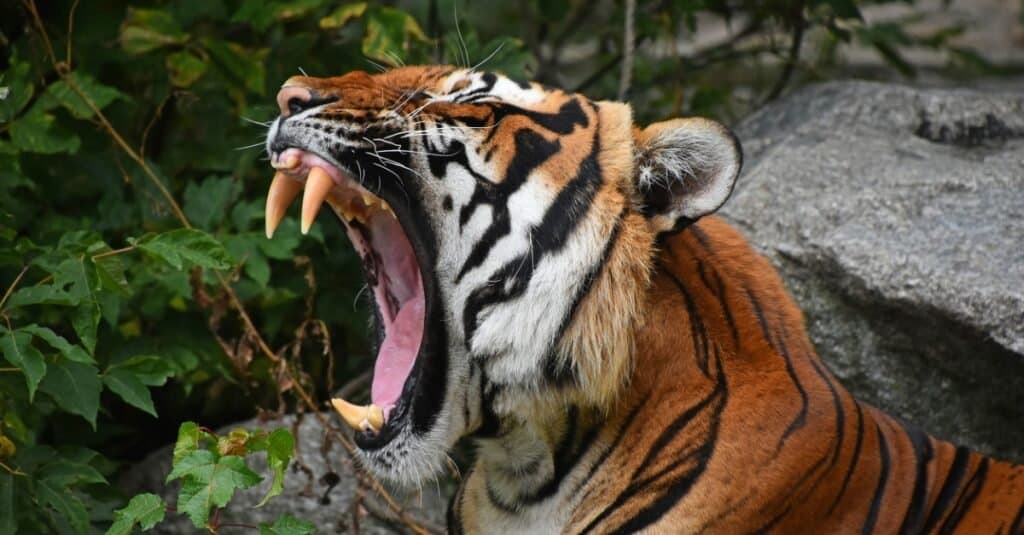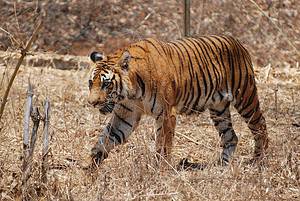Tigers are one of the rarest, and most magnificent creatures in the world. Humans have long been fascinated with them for both their deadliness and alluring beauty. Today, there are fewer than 4,000 tigers remaining in the wild, and many of these are critically endangered. But tigers have more than just beautiful stripes; they also have massive teeth designed for hunting and consuming prey.
Here, we’ll learn more about just what makes a tiger’s teeth so special, and exactly how they use them. Then, we’ll explore the phenomenal bite force of tigers, and whether or not they’re dangerous to humans.
Tiger Milk teeth
Tiger cubs are born toothless. Deciduous (milk) teeth begin to erupt within the first week of life, and by the time the cub is a few months old, it has a full set of razor-like baby teeth. Cubs subsist entirely on mother’s milk until they’re several months old, though they remain with their mother until they’re about two.
At six months of age the cubs begin to develop permanent dentition. As the new, adult teeth, come in, they push out the baby teeth. This ensures that the tiger is never without teeth.
Tiger Adult teeth

Tigers have 30 teeth; 12 incisors, 4 canines, 12 premolars, and 2 molars.
©iStock.com/it:Backiris
There are two extant subspecies of tiger; the continental tiger (Panthera tigris tigris) and the Sunda tiger (Panthera tigris sondaica). Continental tigers include the Bengal, Malayan, Siberian (Amur), and Indochinese subspecies. No matter what kind of tiger it is, they all have the same teeth.
Tigers have 30 adult teeth. Most carnivores have more than this, but the tiger’s jaw is specifically developed to be short and strong. They don’t have room for too many teeth, and indeed–tigers get by just fine with their few teeth.
Incisors
There are 12 incisors in the tiger’s mouth; six on the top and six on the bottom. These are the small, nibbling teeth located at the front of the mouth. The corner incisors (those closest to the canines) are larger than the central or lateral incisors. Tigers use their incisors mainly to pull meat from bones, groom, and occasionally pick berries to eat.
Canines
Tigers have four canines; two on the top and two on the bottom, with two on each side of the mouth. The upper canines are bigger than the lower canines, though they’re both massive relative to the tiger’s size. In fact, tigers have the largest canines of all cats; their upper canines can grow up to 3.5 inches long.
The canines are primarily used for holding onto prey. They have to be strong, as tigers regularly hunt animals bigger than they are.
Premolars
Tigers have 12 premolars; six on the top, and six on the bottom, with six on each side. Beginning with the bottom teeth; the first premolar is smaller than the other two, and has three high peaks (crowns). The middle crown is the highest. The second premolar looks much like the first premolar, with three sharp crowns, the tallest of which is the middle crown. The third premolar however, has only two crowns, and each are about the same size.
In the upper jaw, the first premolar is very small and only has one crown. It resembles an incisor more closely than a premolar. The second and third premolars resemble the bottom premolars, with the third premolar being one of the largest cheek teeth.
Molars
Tigers only have two molars, located in their upper jaws, behind the third premolar. Their molars are so small that they’re almost invisible. Together with the premolars, the tiger’s cheek teeth are called carnassials, and they have one very specific purpose.
What Do Tigers Use Their Teeth For?

Tigers use their teeth to hunt prey and consume meat
©Mary Angela Heys/Shutterstock.com
Tigers are obligate carnivores, which means they don’t need to eat anything but meat. On very rare occasions they may snack on a berry or some loose tree bark, but fruits and vegetables are not an essential part of their diet.
This is where those massive teeth come into play. Some of them are for catching prey, and some of them are for consuming meat.
Hunting
Tigers are ambush predators; they mostly prey on medium to large ungulates like wild pig and sambar deer. They grab the prey with their teeth and claws, using their fearsome canines to grip the animal by the throat or back of the neck. Then, using their extremely sensitive jaws, they either strangulate the animal to death, crush the windpipe, or puncture the jugular vein.
Eating
Once the tiger has found or killed its prey, it’s time to gorge. Tigers can eat over 50 pounds of meat in one sitting, and it’s all possible with the help of their cheek teeth–the carnassials.
Tiger carnassials are designed to work like a pair of scissors, the top teeth occluding against the bottom teeth. Using these teeth, they shear the meat into smaller, bite sized chunks, and swallow it whole. Tigers have no grinding surfaces on their teeth; they don’t need them–all they do is cut meat.
Tiger Bite Force
Tigers have short, squat jaws designed to bite hard. Their jaw muscles attach to a bony ridge on the back of their skull called a sagittal crest. This attachment gives them immense power–enough to deliver over 1,000 PSI of bite force with every bite.
Are Tigers Dangerous to Humans?

As human encroach more on the territory tigers hunt in, deaths have increased.
©iStock.com/BreakingTheWalls
Tigers don’t seek out people to attack, but they are dangerous to humans. This is particularly true in areas where human settlement and activity encroach on tiger habitat, like in India and Bangladesh. Unfortunately, tigers are known to attack humans, and there have been many fatalities as a result.
When travelling tiger country, it’s best to remember that tigers are wild animals. Never approach a wild tiger, and if you do find yourself in tiger territory, be sure to take all proper precautions.
The photo featured at the top of this post is © iStock.com/BreakingTheWalls
Thank you for reading! Have some feedback for us? Contact the AZ Animals editorial team.






